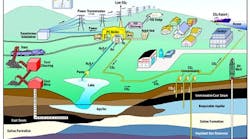Coal-fired power plants play an important role in providing energy at low prices. The reality is that coal is abundant, efficient and less expensive than most other energy options, and will remain an important part of our energy future. Coal accounts for about 50% of electricity production in the United States, and, as shown in Figure 1, it remains a low-cost energy source for U.S. residences. However, coal-fired plants do emit carbon dioxide (CO2), a greenhouse gas (GHG), into the atmosphere, and efforts are underway to improve coal’s environmental performance so that we can take full advantage of this plentiful resource.
“Clean coal technology” describes a new generation of energy processes, some currently available and others being developed, that have the ability to sharply reduce air emissions and other pollutants. These new technological breakthroughs make it possible for new and older coal-burning power plants to produce power in an economical and environmentally responsible manner.
Figure 1. Coal accounts for about 50% of electricity production in the United States, and, as shown in Figure 1, it remains the lowest cost energy source for U.S. residences.
Among the key options under development for use alone or in combination are:
- Optimizing existing plants so they reduce emissions and increase the amount of electricity produced with the same amount of coal.
- Continuing to develop and refine best-available combustion technology, including circulating fluidized-bed (CFB) technology, which includes supercritical and ultra supercritical combustion. This option may also include burning biomass as a fuel, thus reducing the level of CO2 emissions, and oxy-combustion for collecting CO2-rich flue gas.
- Gasification — turning coal into a gas and removing impurities from the coal gas before it is combusted.
- Carbon capture and storage (CCS) — capturing the carbon dioxide from the flue gas and storing it underground or reusing it.
Clean coal is a key component of U.S. energy strategies
The Obama-Biden administration has stated that coal must play a part in our nation’s energy strategy. The White House Energy and the Environment Agenda includes an initiative to develop and deploy clean coal technology. At his Senate confirmation hearing, Dr. Steven Chu, the Obama administration’s Secretary of Energy, stated, “Coal is an abundant resource in the world ... It is imperative that we figure out a way to use coal as cleanly as possible.”
To stimulate the kind of innovative thinking needed to find ways to use coal cleanly, the government funds numerous research projects through the U.S. Department of Energy (DOE) and has pledged to work towards advancing clean coal technologies.
[pullquote]That pledge comes in the form of government co-financing for new coal technologies that help utilities cut pollutants from power plants and demonstrate ways to reduce GHGs by boosting efficiency. Most recently, recognizing that carbon sequestration and storage (CCS) technologies hold enormous potential to reduce GHG emissions from coal-fired power plants, DOE has begun funding projects that use CCS technologies and/or beneficial reuse of carbon dioxide.
The DOE is funding an initiative to equip multiple new clean coal power plants with advanced CCS technology, stating, “As technological advancements have been realized in the last five years, the United States is eager to demonstrate carbon capture and storage technology on commercial plants that when operational, will be the cleanest coal-fired plants in the world.” In addition, the DOE is also participating in a number of international CCS efforts, including projects in Canada, Germany, Australia, Algeria and China.
It is clear that government and its industry partners place high hopes that these public-private partnerships will lead to technology breakthroughs allowing coal-fired plants to continue to provide safe, affordable energy.
Major clean coal technologies under development
Scientists and engineers in the U.S. and abroad are conducting research and demonstration projects to prove that coal can be used to produce energy efficiently and responsibly and, in the process, provide clear evidence that clean coal can in fact play a significant role in our energy future for many years to come.
Optimizing existing coal-fired power plants
Optimizing existing plants is the “low-hanging fruit” of technologies because it makes the best possible use of what we already have. In the United States, optimization includes using sophisticated software to help plants reduce emissions, increase efficiency, lower costs and improve reliability. One example is an integrated online optimization system at a coal-fired plant located in Baldwin, Ill., that led to a 12-14% reduction in nitrogen oxide (NOx) emissions, reduction of ammonia consumption by 15-20%, increase in fuel efficiency and available megawatt hours, and reduction in GHGs, mercury, and particulates.
In the developing world where many coal-fired plants operate far below their design efficiencies because of poor-quality coals, poor plant maintenance, and lack of diagnostic tools and instrumentation, optimization programs could include implementation of low-cost best practices that would save millions of tons of coal, avoid millions of tons of CO2 emissions, and improve the plants’ financial performance. Refurbished power plants would be more efficient and emit less CO2. Plants could also be upgraded with new pollution control equipment to emit less sulfur dioxide, nitrogen oxide, particulates and other emissions, including mercury. Although some demonstration projects have been implemented, much more work is needed in this area, because the economic and environmental payoff would be so significant.
Continuing to develop and refine best-available combustion technology, including CFB technology and oxy-combustion
- National Energy Technology Laboratory (NETL)
- Gasification Technologies Council (GTC)
- U.S. Department of Energy
- Clean Coal Today, Office of Fossil Energy, U.S. Department of Energy, Issue No. 78, Winter 2008
- Fossil Energy Techline
- Clean Coal Technology and The Clean Coal Power Initiative
Circulating fluidized-bed (CFB) technology is an existing technology that is being used to burn coal and other fuels to produce energy in a clean, environmentally responsible way. CFB is a clean coal combustion platform with a unique low-temperature combustion process that can burn both traditional fuels and carbon-neutral fuels, including biomass, waste coals, tires and processed waste materials. The technology can be used to significantly reduce CO2 emissions to the atmosphere.
Unlike conventional steam generators that burn the fuel in a high-temperature flame, CFB technology does not have burners or a flame within its furnace. CFB uses fluidization technology to mix and circulate fuel particles with limestone as they burn in a low-temperature combustion process. The limestone captures the sulfur oxides as they are formed, while the low-burning temperature minimizes the formation of nitrogen oxides.
The fuel and limestone particles are recycled back into the process, which results in high efficiency for burning the fuel, capturing pollutants and for transferring the fuel’s heat energy into high-quality steam to produce power.
CFB technology is now being integrated with vertical-tube, once-through unit (OTU) supercritical steam technology, which provides the best combination of features for efficient, cost-effective and environmentally responsible power production. The innovative boiler design uses Benson vertical-tube supercritical once-through steam technology for the evaporator steam circuit.
Gasification
Gasification is a manufacturing process that converts any material containing carbon, including coal, into synthesis gas (also known as syngas). The syngas can be burned to produce electricity.
Research is being conducted on Integrated Gasification Combined-Cycle (IGCC) systems, in which the syngas is burned as fuel in a combustion turbine to drive an electric generator. Exhaust heat from the combustion turbine is recovered and used to boil water, creating steam for a steam turbine-generator.
The use of these two types of turbines together (combined cycle) is one reason why gasification-based power systems can achieve high power generation efficiencies. Research suggests that future IGCC systems may achieve efficiencies approaching 45%, and the goal is to achieve efficiencies as high as 60%. By comparison, a conventional coal-based boiler plant that uses only a steam turbine-generator is typically limited to efficiencies of 33-40%, although it may achieve 45% or better under some conditions.
Higher efficiencies mean that less fuel is used to generate the rated power, resulting in lower costs and the formation of fewer greenhouse gases. For example, a 60%-efficient gasification power plant could cut the formation of carbon dioxide by 40% compared to a typical coal combustion plant.
Carbon capture and storage
Carbon capture and storage (CCS) means separation and capture of CO2 from fossil fuel-fired power plants, and the recovery of a concentrated stream of CO2 that can be transported by pipeline and stored in either an underground formation or the sea bed. Most research efforts are focused on systems for capturing CO2 from coal-fired power plants because they are the largest stationary sources of CO2. Figure 2 illustrates what such a system might look like at a typical coal-fired power plant.
Figure 2. How carbon capture and storage might work at a typical coal-fired power plant
CCS technologies include post-combustion (captures CO2 from power plant flue gases), pre-combustion (widely used in fertilizer manufacturing and in hydrogen production without any CCS) and oxy-fuel combustion (still in the demonstration phase, but showing great potential because recycling the flue gas through the boiler concentrates the CO2 level in the flue gas, making it easier to separate the CO2.)
According to the DOE’s National Energy Technology Laboratory, “CCS technologies, if commercialized and widely deployed, would allow us to continue using fossil fuels in tandem with the existing energy infrastructure… As we continue to use current fossil energy sources for years to come, we need ways to control CO2 emissions for the energy systems we’re using… By attacking the problem from several fronts — energy conservation, expanded use of renewables, as well as CO2 emission controls including CO2 capture and sequestration, on existing and new systems — we have the best chance at reducing GHGs while maintaining a strong economy, which requires energy at a reasonable cost.”
Coal in our future
Despite the many commendable efforts taking place to develop sustainable forms of power generation, coal and other solid fuels are likely to remain an essential part of the nation’s energy picture for many years to come. As one of the nation’s lowest-cost electric power sources for the foreseeable future, coal will remain a necessary and important part of U.S. energy production. The nation is turning to clean coal technologies as a way of making use of this abundant and available resource in the most environmentally responsible way possible. New coal technology promises to balance environmental and economical concerns, while continuing to satisfy our growing world with energy output.
Robert S. Giglio is the Director of Global Marketing and Strategy for the Foster Wheeler Global Power Group. In this role, Giglio supports the Global Sales and Marketing Group (GSM) within the Global Power Group (GPG) with all marketing efforts. An MSME graduate of the Massachusetts Institute of Technology in Cambridge, Mass., Giglio has been with the company since 1994.


